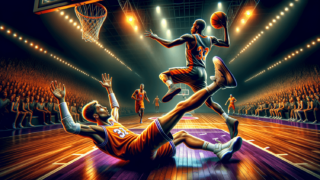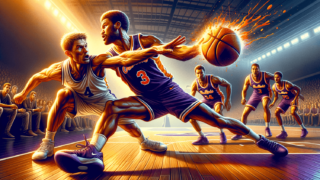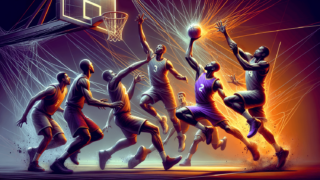
Continuation Rule in Basketball: When Does It Apply?
Written by: Basketball Universe
Last updated:

If you’ve ever found yourself watching a basketball game, puzzled by an official’s call after a spectacular play, then you’re not alone. Perhaps one of the most intriguing and debated aspects of basketball is the mysterious “Continuation Rule”. In this fun and professional blog post, we’re unraveling the enigma and diving deep into the nuances of the rule, its applications, and its occasional controversies. So grab your whistle and lace up your sneakers as we embark on a thrilling journey to answer the million-dollar question: When does the continuation rule in basketball apply?
Continuation Rule in Basketball: When Does It Apply?
The Continuation Rule in basketball applies when a player is fouled in the act of shooting or on the move to the basket, and the shot is made or the player maintains control of the ball. In this scenario, the basket counts, and the fouled player is awarded one free throw if the shot is successful or two free throws (or three, in case of a 3-point attempt) if the shot misses. This rule is designed to prevent defenders from consistently fouling players to disrupt offensive plays.
Origins of the Continuation Rule
Understanding the origins of the continuation rule in basketball provides the necessary context to appreciate its significance. The rule was born out of a desire to ensure that the game remains fast-paced and exciting, focusing on the players’ athleticism and skill. Its roots trace back to the 1960s when the sport saw several rule changes aiming to make the game more entertaining for fans and television audiences. The continuation rule evolved over the years to become what it is today – a defining element of basketball that often sparks discussions and debates.
Unraveling the Concept: The Continuation Rule Explained
Before we dive deeper into the subtleties of the continuation rule and its various applications, let’s first clarify the core principle that governs this particular aspect of basketball rules. In the simplest terms, the continuation rule is present to ensure that players are rewarded for their skill and effort when fouled during the act of shooting or moving to the basket.
Fouled in the Act of Shooting
When a player is fouled during the act of shooting and still manages to make the shot, the basket counts, and they are awarded one free throw. If the player misses the shot but is fouled, they are given either two free throws (regular field goal attempt) or three free throws (3-point attempt) depending on where the shot was taken from. The key here is to determine whether the player was fouled “in the act of shooting” or not, which involves analyzing factors such as player movement, intention, and the timing of the foul.
Fouled While Moving to the Basket
The continuation rule also applies when a player moving to the basket is fouled, maintains control of the ball, and completes their shot. In this scenario, the basket is counted, and the player is granted one free throw. Sometimes, it may seem that a player is fouled too early for the continuation rule to apply; however, if the player demonstrates a clear intention to shoot and there is a “continuous motion,” the rule comes into effect.
When Does the Continuation Rule Not Apply?
It’s essential to understand when the continuation rule does not apply, as it helps to paint a clearer picture of where the line is drawn. It prevents incorrect assumptions about the rule and potential confusion during games. Primarily, the continuation rule does not apply in the following cases:
Loose Ball Fouls
When both teams’ players are scrambling for a loose ball and a player commits a foul, the play is stopped immediately, and the continuation rule does not apply. This is because neither team has clear possession of the ball and no player is in the act of shooting or moving to the basket.
Fouled Before the Shooting Motion Begins
If a player is fouled before they begin the act of shooting or the shooting motion, the continuation rule does not apply. An example of this scenario is when a player with the ball is fouled as they pivot or initiate a dribble move. It could also occur when a player is fouled before lifting the ball for a shot, with the foul occurring during a pump fake.
Offensive Fouls
If an offensive player commits a foul during their shot, such as charging, pushing off, or using their off-arm to create space, the continuation rule does not apply, and the basket does not count. In this case, the defending team is rewarded for the foul by regaining possession of the ball, and the offensive player’s violation nullifies the impact of the continuation rule.
NBA vs. FIBA: Distinct Interpretations
While the fundamental concepts of the continuation rule remain consistent across different basketball organizations, it’s important to note that some key distinctions in how the rule is interpreted and applied may exist. In particular, the National Basketball Association (NBA) and the International Basketball Federation (FIBA) have differing rules on what constitutes “continuous motion” and the “act of shooting.”
Continuous Motion in the NBA
The NBA generally has a broader interpretation of continuous motion, which, in turn, has led to a more liberal application of the continuation rule. Essentially, the NBA allows players who have maintained a single, uninterrupted motion to continue their play even after being fouled. This, at times, results in what seems like an excessive number of steps after the foul, which, in any other context, would be considered traveling.
FIBA’s Take on Continuation
FIBA, on the other hand, has a stricter approach to the continuation rule, and as such, its interpretation of what constitutes “continuous motion” is narrower. FIBA emphasizes that a player should begin the act of shooting or be in the process of shooting when fouled for the continuation rule to apply. This approach puts the focus more on the act of shooting rather than the player’s overall movement, making it less forgiving and causing it to be applied less frequently.
Common Misconceptions & Controversies
Given the complexity of the continuation rule and the variations in its interpretation across different leagues, controversies and misconceptions regularly arise. Let’s address some of the most common ones to promote a clearer understanding of the rule.
Misconception: A Set Number of Steps Determines Continuation
Many fans incorrectly believe that the continuation rule is determined by the number of steps a player takes after being fouled. However, the rule focuses on the player’s continuous motion and intention to shoot, rather than a strict step count. While the NBA generally allows more steps after a foul, it is the continuation and fluidity of the motion that matters.
Controversial Calls
Another common contention with the continuation rule is what constitutes the act of shooting. Different ways in which the rule is enforced throughout various stages of the game, such as regular play versus playoff games, may lead to heated debates. Some critics argue that the continuation rule may be inconsistently applied, leading to tense moments and pivotal calls that can alter the course of a game.
Mastering the Continuation Rule as a Player and Coach
Understanding and mastering the continuation rule has numerous benefits for players and coaches alike. It can provide a strategic advantage in tight games, boost players’ confidence, and improve overall team performance. Here are some practical tips for both players and coaches to leverage the continuation rule:
For Players:
1. Develop the ability to recognize and anticipate fouls during the act of shooting. This understanding can help players maintain concentration, complete their shots, and potentially earn free throws.
2. Focus on practicing continuous motion after being fouled. Use drills simulating contact during shooting to help build muscle memory that allows a player to complete their shot despite contact.
3. Work on drawing fouls in tight spaces, particularly when driving to the basket. It not only increases the chances of a continuation opportunity but also puts pressure on the opposing team’s defense.
For Coaches:
1. Reinforce the importance of awareness and understanding of the continuation rule during practices, emphasizing the potential benefits during tight games.
2. Customize drills and scrimmage situations to include fouls during the act of shooting, teaching players how to recognize and adapt to these scenarios.
3. Make it a priority to communicate with referees regarding continuation rule interpretations, ensuring that the team is well prepared and fully aware of the possible implications.
By mastering the continuation rule and understanding its fundamentals, intricacies, and potential misconceptions, basketball enthusiasts, as well as players and coaches, can gain a deeper appreciation for the sport. While it may be difficult at times to determine when the continuation rule does (or doesn’t) apply, possessing a solid grasp of the rule allows individuals to engage with the game on a meaningful level and enhance their overall experience. Whether you’re watching an intense NBA game or participating in a local league, this unique aspect of basketball rules will continue to captivate the minds and hearts of fans everywhere.
Refining Your Approach to Fouls and Continuations
Another critical aspect of understanding and applying the continuation rule effectively is recognizing how to fine-tune your approach to different fouling situations. This includes both defending against potential continuation situations and capitalizing on them on the offensive end. Here are some essential tips for both offensive and defensive players:
For Offensive Players:
1. Be aware of your defenders’ positioning and tendencies, especially when attempting to draw fouls. Having a clear understanding of their habits and aggressiveness will help you exploit weaknesses and maximize your chance of success.
2. Disguise your intentions by using misdirection, quick changes of pace, or subtle gestures. This will help make it difficult for defenders to anticipate your actions, improving the likelihood of inducing a foul and potentially benefitting from the continuation rule.
3. Build on your basketball I.Q. by regularly studying game footage and analyzing how successful players draw fouls and create continuation scenarios. Emulate their tactics and techniques while adapting them to your unique skillset.
For Defensive Players:
1. Avoid reaching or committing unnecessary fouls, particularly against players who excel at converting continuations. Playing solid defense and maintaining proper body position is critical in negating any potential continuation opportunities.
2. Improve your understanding of the specific rules and interpretations within your league or competition. This will allow you to anticipate how refs may apply the rule during games, which, in turn, can help you better prepare yourself defensively.
3. Utilize smart defensive techniques such as verticality, quick footwork, and active hands to limit the offensive players’ space and shot opportunities without fouling them during the act of shooting. Proper communication and collaboration with your teammates can also help deter continuation scenarios.
The Continuation Rule’s Impact on Game Strategy
An often-overlooked aspect of the continuation rule is its impact on game strategy and decision-making. Coaches and players can use their in-depth knowledge of the rule to create game plans that give their team a competitive edge. This strategic use of the continuation rule goes beyond mere tactics and involves factors such as matchup analysis, game clock management, and fouling tendencies:
Exploiting Matchups
Identifying and exploiting favorable matchups is a key part of basketball strategy. A player proficient at drawing fouls and capitalizing on the continuation rule can create distinct advantages against defensive players who are prone to fouling or less athletic. This could lead to potential mismatches on the court, increasing your team’s chance of success.
Managing the Game Clock
Strategic use of the continuation rule can impact game clock management. With the game on the line or in foul-heavy scenarios, offensive players can increase their attempts to draw fouls, causing the clock to stop more frequently. This, in turn, may provide additional opportunities for comebacks or extended leads.
Adjusting to Opponents’ Fouling Tendencies
Recognizing and adjusting to an opposing team’s fouling tendencies can be crucial in developing a successful game plan. For instance, if an opponent’s defensive scheme is aggressive, an emphasis on driving to the basket and drawing fouls may create opportunities for continuations and subsequent free throws.
As we’ve explored, the continuation rule in basketball is an essential aspect of the game that encompasses on-the-court mechanics, strategies, and crucial decision-making. Implementing lessons and insights gained from understanding the rule—from both offensive and defensive perspectives—can give players, coaches, and teams the tools they need to thrive on the court. Whether you’re an aspiring player or an avid fan, comprehending the continuation rule not only adds to your overall knowledge of the game but also bolsters your appreciation for the tactical and strategic elements that make basketball so captivating.
FAQ Section: Frequently Asked Questions About the Continuation Rule
As such a fascinating and intricate aspect of basketball, the continuation rule naturally sparks numerous questions amongst enthusiasts, players, and coaches alike. To help satisfy your curiosity, we’ve compiled some of the most common questions and provided concise answers to enhance your understanding of this unique aspect of the game.
1. What is the main purpose of the continuation rule in basketball?
The continuation rule’s main purpose is to maintain the game’s fast-paced and exciting nature by rewarding players for their skill and effort when fouled during the act of shooting or while moving to the basket.
2. How is the continuation rule different in the NBA and FIBA?
The primary difference lies in what is considered “continuous motion.” The NBA generally has a broader interpretation, often allowing more steps after a foul, while FIBA rules are stricter, focusing more on the act of shooting rather than overall player movement.
3. Can the continuation rule be applied on offensive fouls?
No, the continuation rule does not apply to offensive fouls. If the offensive player commits a foul during their shot, the basket does not count, and the defending team regains possession of the ball.
4. What happens when a player is fouled in the act of shooting and makes the basket?
If a player is fouled in the act of shooting and makes the basket, the points count, and the player is awarded one free throw, regardless of the shot being a 2-pointer or a 3-pointer.
5. How many free throws are awarded if a player is fouled during a 3-point attempt and misses the shot?
If a player is fouled during a 3-point attempt and misses the shot, they are awarded three free throws.
6. Does the continuation rule apply to loose ball fouls?
No, the continuation rule does not apply to loose ball fouls because neither team has clear possession during such plays, and no player is in the act of shooting or making a move to the basket.
7. What does the term “continuous motion” mean in the context of the continuation rule?
Continuous motion refers to the fluid, uninterrupted movement of the player that occurs during shooting or driving to the basket. It is a critical factor in determining whether the continuation rule applies or not.
8. Does the continuation rule apply if a player is fouled before the shooting motion begins?
No, if a player is fouled before they begin the act of shooting, the continuation rule does not apply. The play is stopped, and the game proceeds according to the specific rules regarding personal fouls.
9. Can a player be awarded a continuation if they lose control of the ball after being fouled?
No, a continuation is not granted if a player loses control of the ball after being fouled. The player must maintain control of the ball to benefit from the continuation rule.
10. How can players and coaches use the continuation rule strategically during games?
Players and coaches can use their knowledge of the continuation rule to exploit favorable matchups, manage the game clock, and adjust to opponents’ fouling tendencies. This strategic understanding can contribute to a team’s overall success and performance on the court.
Featured Posts
- No pillar pages found.





